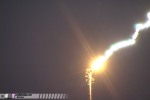What color is lightning?
|
In September of 2025, my work is generating the most income it ever has in my career. Yet, I'm being forced to shut down my successul operation, against my will, due to one cause alone: 95% of that revenue is being stolen by piracy and copyright infringement. I've lost more than $1 million to copyright infringement in the last 15 years, and it's finally brought an end to my professional storm chasing operation. Do not be misled by the lies of infringers, anti-copyright activists and organized piracy cartels. This page is a detailed, evidenced account of my battle I had to undertake to just barely stay in business, and eventually could not overcome. It's a problem faced by all of my colleagues and most other creators in the field. |
Lightning traveling through open air emits white light, but can appear in different colors depending on local atmospheric conditions. Distant lightning can appear red or orange the same way the setting sun does, due to moisture, haze, dust, etc in the lower levels of the atmosphere. Light emitted by lightning has a similar visible spectrum as sunlight (white light), so the atmosphere should shift the colors of both the same way - given there is enough distance between the lightning and the observer.
When lightning strikes an object or the ground, the lightning channel is often a deep red or orange color for its last ten feet or so above the ground or the target object. Lightning striking a tree will appear a bright, fiery orange/red color for the length of the channel traveling down the tree.
Lightning photographs: The hue of lightning channels in photographs is usually a function of the type of film, camera, exposure, white balance and/or recording media used. The same lightning channel can appear blue, purple, red or orange depending on the type of film, length of exposure, and other factors. Slide film is more likely to produce a more purple/blue image, while print film tends to give lightning a more yellow/orange tint.
BELOW: Lightning shot on some slide films (LEFT and CENTER) tends to appear blue or purple, while lightning photographed on most print film (RIGHT) tens to appear brown or yellow.
  
BELOW LEFT: The lower few feet of lightning striking an object will often appear orange or red. RIGHT: Lightning channels appear fiery red and orange when traveling down a tree.
 
Green Lightning?
Green/turquoise flashes and/or changing colors: A flash of light in the sky that lingers, pulses and/or changes colors is not lightning, but electrical arcing from shorted-out power lines. These arcs are called 'power flashes' and can be triggered by a variety of severe weather - including ice storms, high winds, tornadoes, or by a direct lightning strike. Electrical arcing, whether caused by lightning, ice or wind damage, is very intense, can be as bright as lightning, can illuminate the entire sky and can change color from blue, green, turquoise, red and orange. When lightning strikes an energized power line, an electrical flashover arc can result. Lightning-triggered flashover arcs usually begin during the strike and linger for a few seconds after the strike is over. See our article about flashover arcs for a more in-depth look.
Power flashes are often incorrectly referred to as 'exploding transformers'. Only a few power flashes are actually transformer explosions - most are caused by shorted-out lines due to broken, crisscrossed or fallen wires.
Below is an image of a power flash caused by falling tree limbs during an ice storm in St. Louis, Missouri:

 About the Author: Dan Robinson has been a storm chaser, photographer and cameraman for 33 years. His career has involved traveling around the country covering the most extreme weather on the planet including tornadoes, hurricanes, lightning, floods and winter storms. Dan has been extensively published in newspapers, magazines, web articles and more, and has both supplied footage for and appeared in numerous television productions and newscasts. He has also been involved in the research community, providing material for published scientific journal papers on tornadoes and lightning. |
See Also:
GO: Home | Storm Chase Logs | Photography | Extreme Weather Library | Stock Footage | Blog
Featured Weather Library Article:
|